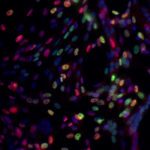Lien vers Pubmed [PMID] – 20133858
Lien DOI – 10.1073/pnas.0906355107
Proc Natl Acad Sci U S A 2010 Feb; 107(5): 2141-6
Bridging broken DNA ends via nonhomologous end-joining (NHEJ) contributes to the evolution and stability of eukaryote genomes. Although some bacteria possess a simplified NHEJ mechanism, the human commensal Escherichia coli is thought to rely exclusively on homology-directed mechanisms to repair DNA double-strand breaks (DSBs). We show here that laboratory and pathogenic E. coli strains possess a distinct end-joining activity that repairs DSBs and generates genome rearrangements. This mechanism, named alternative end-joining (A-EJ), does not rely on the key NHEJ proteins Ku and Ligase-D which are absent in E. coli. Differently from classical NHEJ, A-EJ is characterized by extensive end-resection largely due to RecBCD, by overwhelming usage of microhomology and extremely rare DNA synthesis. We also show that A-EJ is dependent on the essential Ligase-A and independent on Ligase-B. Importantly, mutagenic repair requires a functional Ligase-A. Although generally mutagenic, accurate A-EJ also occurs and is frequent in some pathogenic bacteria. Furthermore, we show the acquisition of an antibiotic-resistance gene via A-EJ, refuting the notion that bacteria gain exogenous sequences only by recombination-dependent mechanisms. This finding demonstrates that E. coli can integrate unrelated, nonhomologous exogenous sequences by end-joining and it provides an alternative strategy for horizontal gene transfer in the bacterial genome. Thus, A-EJ contributes to bacterial genome evolution and adaptation to environmental challenges. Interestingly, the key features of A-EJ also appear in A-NHEJ, an alternative end-joining mechanism implicated in chromosomal translocations associated with human malignancies, and we propose that this mutagenic repair might have originated in bacteria.



